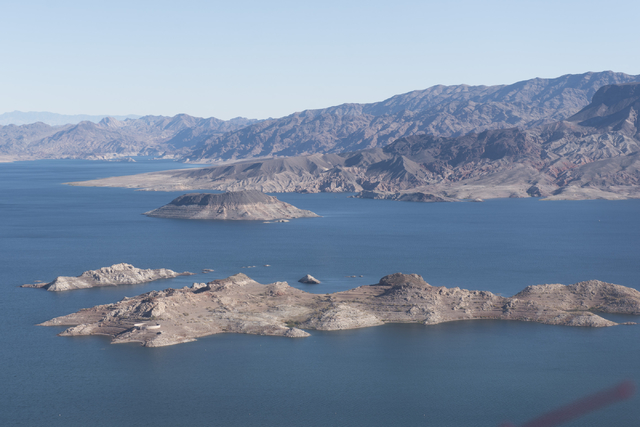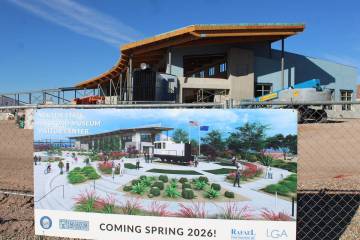Dam precious resource: Despite drought, precautions in place reduce threat to lake levels
Though the worst drought on record has been plaguing the Colorado River since 2000, the water situation for Boulder City residents may not be as dire as some people believe, according to multiple sources.
Daniel Bunk, river operations group manager for the Bureau of Reclamation, Lower Colorado Region, said Lake Powell provides a buffer that has helped curb the amount of water lost each year at Lake Mead, which currently sits at about 1,087 feet, a low it hasn’t seen since 1956, well before the drought began.
According to Bunk, Lake Powell, which straddles the border of Utah and Arizona, and stores water for the Colorado River’s upper basin, has reduced the average 8 foot loss per year at Lake Mead to between 3-4 feet per year.
Nevada is one of seven states allocated water from the 1922 Colorado River Compact, which was created to govern water rights as the areas developed
Southern Nevada currently uses less than 2 percent of the water taken from the Colorado River basin. The state’s annual allocation of water is 300,000 acre feet, which is the equivalent of 3 feet of lake elevation, said Corey Enus, public information coordinator for the Southern Nevada Water Authority, adding that the state uses only two-thirds of that amount.
Water savings
Additionally, conservation efforts have reduced the amount of water drawn from the lake, which sits close to 10 feet above shortage efforts.
Nearly two-thirds of the total water use in Southern Nevada comes from outdoor use, primarily landscaping, but since the drought began the area has instituted strict development codes and usage restrictions.
Codes put in place in 2003 prohibit the installation of grass in commercial developments and severely limit its use for new residences. Restrictions on use include the time of day watering is allowed, water budgets for golf courses and promotion of water-smart landscaping.
Since 1999, the region has pushed dessert landscaping as a means of saving water, and during that time the program has removed 181 million square feet of turf, which equates to approximately 98 billion gallons of water saved. According to Enus, all of these programs have been extremely successful.
“Since 2002, Southern Nevada has reduced water consumption from Lake Mead by 37 percent, or about 34 billion gallons, even though the area’s population increased by more than a half-million people during that same time period,” Enus said. “People tend to correlate growth with a one-to-one increase in water consumption, but that has not been the case in Southern Nevada.”
The Las Vegas Valley also returns nearly 100 percent of its indoor-use water to Lake Mead through water treatment facilities and the Las Vegas Wash, bringing the water up to drinkable quality. In addition, every gallon that is returned allows the city to extend its allocation an equal amount.
Local growth
While Boulder City participates in the water-saving programs that have proven so effective, the city does not have access to a system that returns water to the lake. However, water used by residents is treated locally and then reused in nondrinking functions, according to Enus.
City Council member Duncan McCoy said that some of the residents against growth were trying to scare people, making the situation sound worse than it is.
“If you talk about our water use in gallons, it sounds like a lot; we’re using billions of gallons a year,” McCoy said. “But that’s not how you measure water use, you use acre-feet. We have a budget of about 18,700 acre-feet per year and we only use about 12,000.”
Though in the 1970s the city drew most of its water from underground, now 90 percent of the water comes from the lake, he said, which has allowed the aquifer to recharge, adding another source of protection. McCoy said that the town is prepared for shortage conditions as well as growth, though he thinks it is unlikely people in the city will vote for it.
“The water authority and the Colorado River Commission have made it clear we are prepared for the future,” McCoy said. “However, all that we have now is a proposal. It would require a vote before anything could happen. People would have to stand up in support and I’m not sure that’s likely to happen.”
Enus said that the water authority’s plans were focused as far as half a century into the future.
“We are a proactive agency, with the drought and climate change we cannot afford to be reactive,” Enus said. “We are currently constructing a low lake pumping station that will secure our access even if lake levels drop too low for water to be released from the dam to downstream users. It’s not a matter of if we grow, but how we grow.”
Hydroelectric power
Water may be the most obvious resource the city receives from the dam, but it is not the only one, as it also provides hydroelectric power to Nevada, Arizona and California.
Boulder City is not a major user of the power generated by the dam, accounting for approximately 2 percent in 2016. Nevada’s usage as a whole accounted for about 23 percent of the nearly 3.6 billion kilowatt-hours the dam produced, while California received about 60 percent.
As massive as the lake and the dam may be, the power production depends on the water levels remaining high enough to maintain the pressure that pushes the water down through the dam, according to Rose Davis, public affairs officer for the Bureau of Reclamation, Lower Colorado Region.
The drought has already had a significant impact in this area as the 140 foot reduction in water elevation since 2000 has led to a 25 percent reduction in the dam’s generating capacity, Davis said. Hoover Dam would reach “deadpool” levels at 900 feet of elevation and cease to generate any power.
Currently 187 feet above those level, Davis said there is no way of predicting how far off that threat might be.
“We have no estimates because it’s so variable. There is no crystal ball to tell us if we’re going to have wet or dry years,” Davis said. “We’re continuing to work with our partners on conservation measures and we could gain another partner also. So there’s no basis for projections. That would be speculation.”
Though there are no official projections that run decades into the future, the Lake Mead elevation on Jan. 1, 2018, is projected to be at 1,078 feet, according to Jayne Harkins, executive director of the Colorado River Commission.
That is 9 feet less than current levels and 3 feet above the first shortage determination tier.
In spite of the drought entering its 18th year, Davis said there may be reason for optimism. Like 2011, this year looks ready to break the trend.
“In January the models indicated a 48 percent chance of a water shortage for 2018, but as of Monday that’s dropped to a 34 percent chance,” Davis said
“We’re at 160 percent of the average seasonal accumulation of snow and in January there were higher-than-average inflows into Lake Mead. But there’s no way for us to predict how long these things will last. We just don’t know.”
Contact reporter Hunter Terry at hterry@bouldercityreview.com or call 702-586-6711. Follow him on Twitter @HunterBCReview
Hydroelectricity
Hoover Dam generates an average 4.2 billion kilowatt hours/year.
Average annual use by recipients
Boulder City: 1.7672 percent
Arizona: 18.9527 percent
Nevada: 23.3706 percent
Metropolitan Water District of Southern California: 28.5393 percent
Burbank, CA: 0.5876 percent
Glendale, CA: 1.5874 percent
Pasadena, CA: 1.3629 percent
Los Angeles, CA: 15.4229 percent
Southern California Edison Co.: 5.5377 percent
Azusa, CA: 0.1104 percent
Anaheim, CA: 1.1487 percent
Banning, CA: 0.0442 percent
Colton, CA: 0.0884 percent
Riverside, CA: 0.8615 percent
Vernon, CA: 0.6185 percent
Source: Bureau of Reclamation
Figures are calculated by decades, using rolling averages from 1999-2008
















